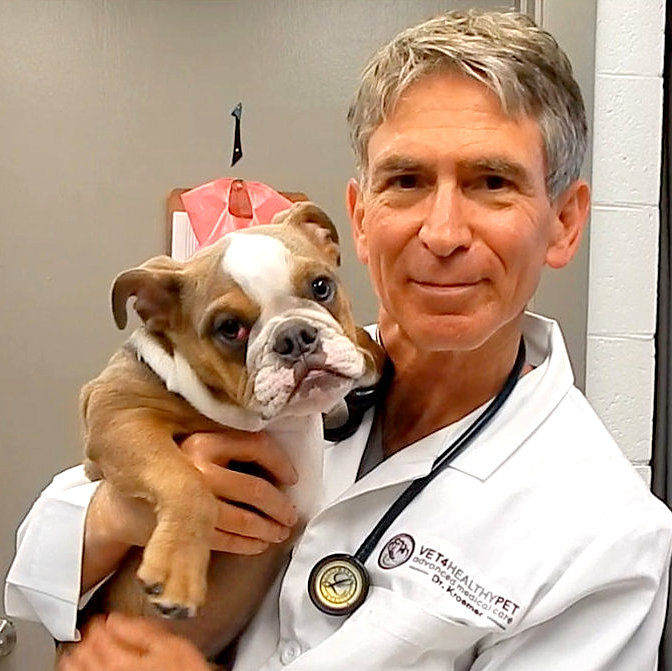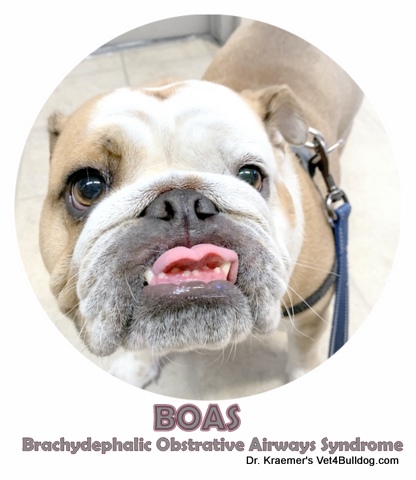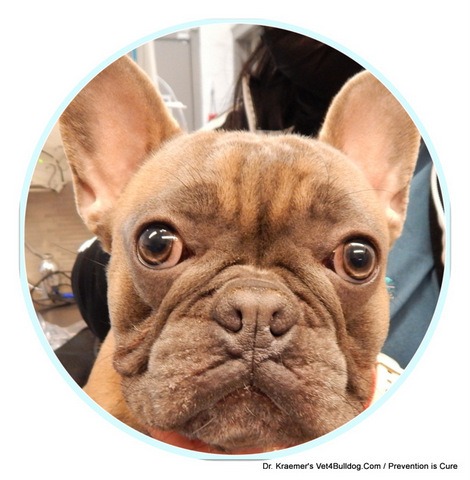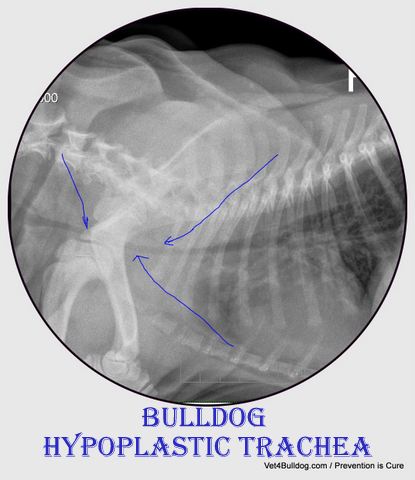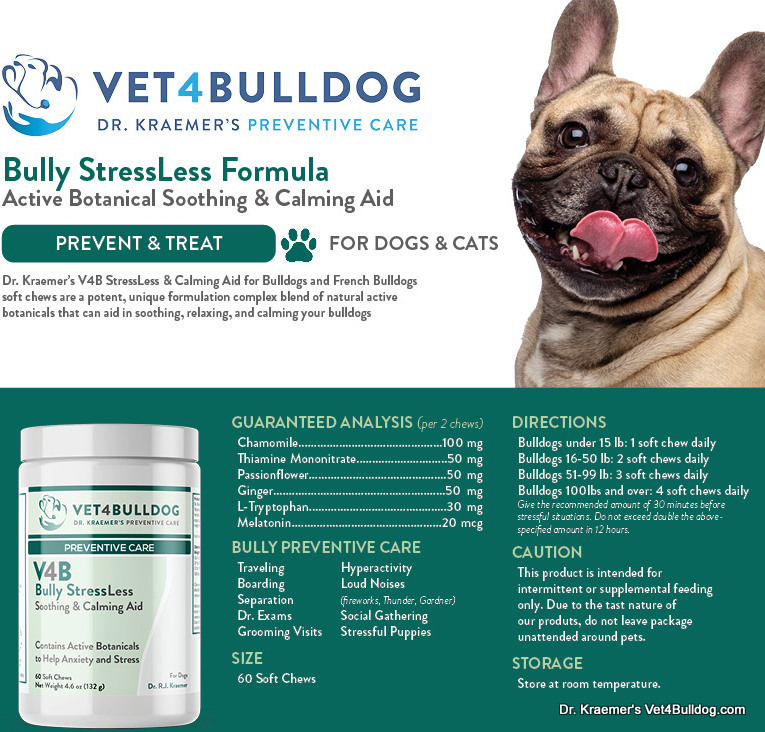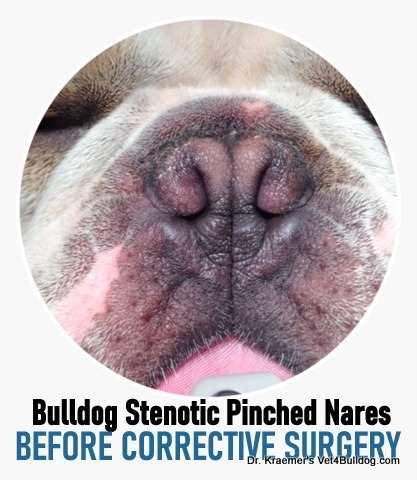BOAS (Brachycephalic Airway Syndrome) in Bulldogs INTRODUCTION:
Brachycephalic Airway Syndrome, also known as Brachycephalic Obstructive Airway Syndrome (BOAS), is a respiratory condition commonly seen in bulldogs and French bulldogs. This syndrome arises due to their distinctive flat-faced, or “brachycephalic,” facial structure. The term “brachycephalic” comes from Latin, meaning “short-headed.”
While this appearance is characteristic of the breed, it unfortunately leads to a range of anatomical issues in the neck and head, affecting the soft tissues and other critical structures. These abnormalities often result in breathing difficulties, which can impact your bulldog’s overall quality of life. Understanding the effects of BOAS is crucial for proper care and management.
Brachycephalic is Latin for “Flat Head”
Bulldog Brachycephalic Obstructive Airway 5 X MUST KNOW
- Stenotic Nares and elongated soft palate are the two most common BOAS
- BOAS is a debilitating, life-threatening respiratory condition that compounds with each other and gets worse over time.
- BOAS usually presents with loud breathing that gets worse during excitement and activity.
- Management includes weight control, a stress-free environment, a cool temperature, supplements, and surgery
- Prevention & Care includes Dr. Kraemer’s Affordable BOAS Bundles
Members of this bulldog community prefer prevention over RX
BOAS in Bulldogs and French Bulldog ANATOMY:
Brachycephalic Obstructive Airway Syndrome (BOAS) in bulldogs refers to a series of primary and secondary anatomical abnormalities affecting the upper airways.
These abnormalities are primarily caused by:
- Airway Narrowing: The constriction of your bulldog’s upper airways.
- Airway Compression: The physical compression of the airways.
- Increased Airway Resistance: higher resistance to airflow in the narrowed air passages.
- Negative Pressure: elevated negative intra-airway pressure, akin to suction.
Imagine your bulldog’s oral cavity, nose, and larynx functioning like a straw being subjected to constant suction. Over time, this can cause the structures to collapse inward. When the negative intra-airway pressure surpasses the strength of the surrounding tissue, it can lead to inflammation, swelling, and edema in the laryngeal area. This further narrows the airways, fatigues, and atrophy, and collapses the laryngeal cartilage, making it even harder for your bulldog to breathe.

BOAS PRIMARY ABNORMALITIES:
- Bulldog Stenotic Nares,
- Bulldog Elongated Soft Palate
- Bulldog Everted Laryngeal Saccules.
- Bulldog Large Thicken Tongue
- Thicken Nasal Plates (Turbinates)
BOAS SECONDARY ABNORMALITIES:
- Bulldog Hypoplastic Trachea
- Bulldog Enlarged Protruding Tonsils
- Bulldog Laryngeal Collapse.
Your bulldog may be affected by a combination of one or more of these BOAS abnormalities.
What Are The Symptoms of Brachycephalic Airway Syndrome?
- Stridor & Stertor
- Acute hyperthermia (as high as 106f)
- Regurgitation & Vomiting
- Esophagitis & Megasecophagus
- Hypoxia (oxygen deficiency)
- Cyanosis (blue-purple tongue due to oxygen deprivation)
- Hacking that leads to Fainting (syncope)
- Asphyxiation
- Pulmonary edema
- Heart failure
- Sudden death
BOAS common labored breathing sounds are:
1. BULLDOG AND FRENCH BULLDOG STRIDOR:
In bulldogs and French bulldogs, a harsh, “mechanical” high-pitched sound made when breathing is a prominent clinical symptom of Brachycephalic Airway Syndrome (BOAS). Exercise, excitement, or warm weather intensify this vibrating sound, which is brought on by turbulent airflow in the larynx.
Breathing becomes more challenging when the symptoms deepen and put more strain on your bulldog’s already constricted airways.
2. BULLDOG AND FRENCH BULLDOG STERTOR:
Stertor is a respiratory sound characterized by heavy snoring, snorting, or gasping during inhalation. In bulldogs and French bulldogs, this occurs due to ongoing conditions such as stenotic (pinched) nostrils or obstructions in the nasopharynx or pharynx.
These obstructions cause turbulence in the airflow, leading to the distinctive sounds of stertor, which can be heard whether the dog is awake or asleep.
3. BULLDOG AND FRENC BULLDOG APNEA:
In severe cases of stertor, bulldogs may experience apnea, a condition where they temporarily stop breathing during sleep or even while awake.
This occurs when the obstructed airways become so restricted that normal airflow is interrupted, leading to pauses in breathing.
🚨 Apnea, combined with the already compromised airway function in bulldogs, can be a serious concern and may require medical intervention to ensure the dog’s breathing is properly managed.
BOAS EARLY INTERVENTION:
🚨 Due to the seriousness of bulldog and French bulldog brachycephalic airway syndrome and its progressive nature, early intervention is critical.
How is BOAS in Bulldogs and French diagnosed?
Diagnosis of Brachycephalic Obstructive Airway Syndrome (BOAS) in bulldogs is based on several factors. A key part of the assessment comes from the owner’s account of the dog’s history and symptoms, including breathing patterns and any signs that worsen during excitement or physical activity. The distinctive breathing sounds, particularly the harsh vibrations and snoring, are also important diagnostic clues.
In some cases, advanced imaging (such as X-rays or CT scans) and a thorough examination under sedation are necessary to evaluate the extent of the airway abnormalities and determine the best course of treatment.
1. STENOTIC PINCHED NOSE
Bulldog stenotic nose means narrowed or pinched nostrils; the narrowing restricts the amount of air that can flow into the nostrils.
Simple visualization during the physical exam will help the diangosis.
2. HYPOPLASTIC TRACHEA:
Bulldogs with BOAS often have an abnormally narrow windpipe, which restricts airflow and proper breathing. This narrowing, along with other upper airway abnormalities, increases airway resistance and negative intra-airway pressure, making breathing more difficult.
However, contrary to common belief, if there are no concurrent respiratory or heart conditions, bulldogs with tracheal hypoplasia can typically manage well. The key is timely surgical correction of other abnormalities, such as an elongated soft palate and stenotic nares, which significantly improve their ability to breathe normally.
Radiographs are usually sufficient.
3. ELONGATED SOFT PALATE:
An elongated palate is one of the most common findings in bulldogs with BOAS. A definitive diagnosis will require anesthesia.
The definitive diagnosis of Brachycephalic Obstructive Airway Syndrome (BOAS) requires a visual inspection by a veterinarian experienced with the condition and laryngeal anatomy.
This examination must be performed under sedation, ensuring the dog’s mouth is fully open with relaxed breathing and proper lighting. This allows the veterinarian to thoroughly assess the extent of airway obstruction and identify specific anatomical abnormalities, such as prolapsed tonsils and laryngeal saccules, which contribute to the syndrome.

3. EVERTED LARYNGEAL SACCULES:
Everted or prolapsed laryngeal saccules are small pouches located just inside the larynx. The saccules are forced outward due to the abnormal negative pressure caused by increased respiratory effort. This outward bulging further obstructs the airway, worsening breathing difficulties.
Just like the elongated palate, the diagnosis requires sedation, ensuring the dog’s mouth is fully open with relaxed breathing and proper lighting.
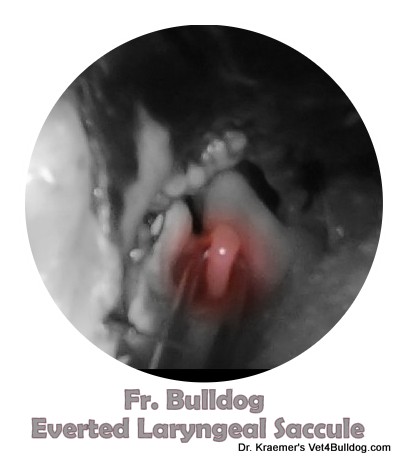
4. LARYNGEAL COLLAPSE:
The definitive diagnosis is a visual inspection combined with a respiratory-stimulating drug. and must be done under mild sedation and proper illumination.
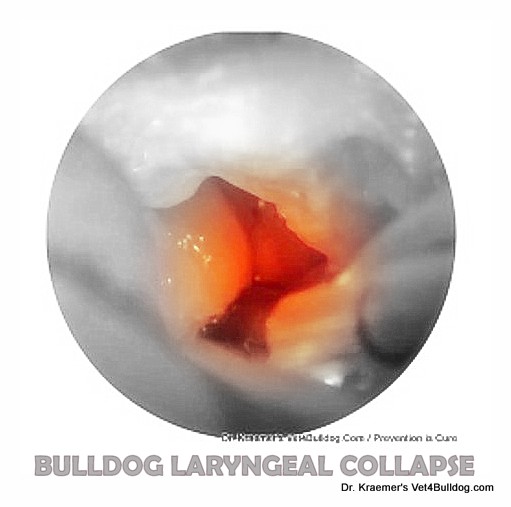
BOAS Brachycephalic Airway Syndrome in Bulldogs PREVENT & TREAT:
- Weight Control: Managing your bulldog’s weight is essential, as excess weight can worsen BOAS symptoms and strain the respiratory system.
- Activity Restriction: Limit exercise and keep excitement levels low to prevent overexertion, which can exacerbate breathing difficulties.
- Climate Control: Avoid exposing your bulldog to hot or humid environments. Ensure good airflow with fans to help regulate temperature and reduce respiratory distress.
- Calm and Relaxed Environment: Minimize stress by maintaining a calm setting. Consider using supplements like Dr. Kraemer’s V4B Bully Calm & StressLess Chews. to help your bulldog stay relaxed.
Brachycephalic Restrictive Airways Surgery Correction:
It’s important to emphasize that while medical management can alleviate the symptoms of BOAS, it does not correct the underlying anatomical abnormalities. These treatments provide temporary relief but do not offer a permanent solution.
Surgery, on the other hand, is the preferred option for a long-term fix, as it directly addresses the structural issues causing respiratory difficulties.
Surgical intervention is recommended when these abnormalities significantly impair normal breathing

1. STENOTIC NARES SURGICAL REPAIR
Bulldog and French bulldog Stenotic Nares can be surgically corrected by removing a wedge of tissue from the nostrils
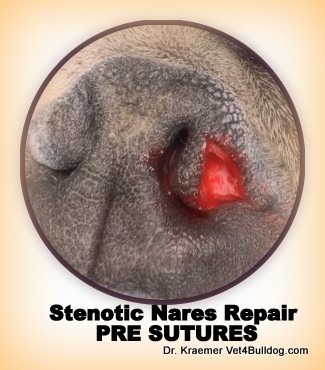
2. ELONGATED SOFT PALATE TRIM
The elongated soft palate obstructs the airway and is critical to proper respiration. To alleviate this obstruction and improve breathing, it should be surgically trimmed as early as possible, ideally when your bulldog reaches maturity. Early intervention is essential to prevent further respiratory complications and ensure long-term health.
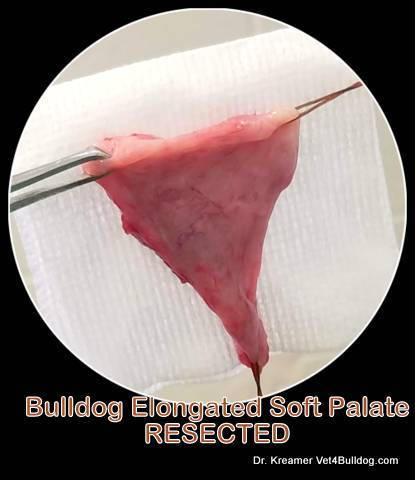
3. EVERATED LARYNGEAL SACCULES REMOVAL
To restore proper airflow, the prolapsed saccules should be surgically removed.
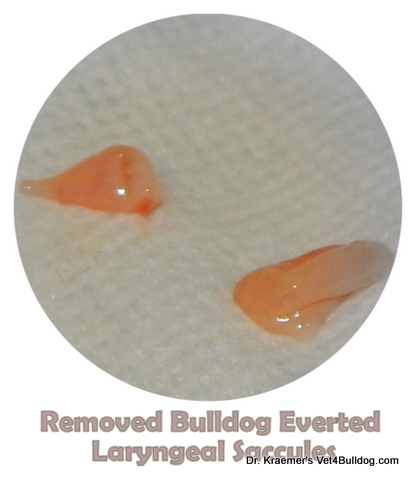
Brachycephalic Airway Syndrome in Bulldogs and French Bulldogs PROGNOSIS:
The prognosis for brachycephalic breeds largely depends on the number and severity of anatomical abnormalities identified at diagnosis and how promptly they are addressed.
Early detection and timely intervention are critical factors in improving their long-term health outcomes.
Brachycephalic Airway Syndrome in Bulldogs RULE OF THUMB:
The severity of Brachycephalic Airway Syndrome symptoms worsens as the number of anatomical abnormalities increases. Timely surgical correction of these abnormalities greatly improves the prognosis, leading to better long-term health and significantly enhanced breathing. Early intervention is critical for preventing further complications and ensuring a higher quality of life.
Bulldogs and Fr. Bulldogs BOAS TIPS & WARNINGS:
Below are a few BOAS essential tips and warnings, courtesy of Dr. Kraemer
#1 🩺 BOAS SURGERY TIP:
I recommend surgical repair of the elongated soft palate and/or stenotic nares once your bulldog reaches maturity, typically around 8 months of age. Early intervention at this stage can prevent the progression of Brachycephalic Airway Syndrome and improve overall respiratory function, ensuring a healthier future for your bulldog.
#2 🩺 BOAS HEAT STROCK TIP:
In the event of a respiratory crisis, it’s important to check your bulldog’s rectal temperature. The normal range is between 100-102.5°F. If their temperature exceeds 105°F and you cannot get to a veterinary hospital, rinse your dog with cool (not cold) water and position a fan over them until the temperature drops to 103°F.
Be cautious not to let it fall below 100°F.
#3 🩺BOAS POSITIONING & TONGUE TIP:
In a respiratory crisis, the thick,, large tongue of a bulldog can retract inward, worsening the situation. If your bulldog is in distress or collapses, make sure they are positioned sternal (lying on their chest with their chin down, rather than on their side). Gently pull the tongue forward to keep the airway open. Continuously monitor the tongue’s color—pink indicates normal oxygen levels, while a purple-blue color signals severe oxygen deprivation and requires immediate attention
#4 🩺BULLDOG ASPIRATION PNEUMONIA TIP:
Bulldogs suffering from BOAS often gag and vomit. To prevent aspiration (i.e., aspiration pneumonia), you should:
- SLOW FEEDING: Don’t let your bully eat or drink too fast. To slow them down, use cupcake cups or place objects in their water/food dish.
- SOFT FOOD: use a blended diet and mix it with water to form a thick, soupy meal.
- SMALL & FREQUENT: Feed smaller portions and more frequent meals
- ELEVATED FEEDING: feed your dog on a step to elevate his upper body; the more vertical, the better.
- ANTI-ACID RX: Lastly, to decrease stomach acidity and gastric reflex, discuss with your vets daily RX like anti-acids (i.e., pepsin-c and Prilosec) and antiemetic (anti-vomit) medication.
#5 🩺BULLDOG HARNESS TIP:
I recommend a harness rather than a neck collar to prevent airflow restriction (all bulldogs)
#6 🩺BULLDOG ANESTHESIA SAFETY TIP:
Review my anesthesia & Sedationchapter for tailored recommendations. I’ve developed customized pre-anesthesia protocols specifically for bulldogs, which include anti-vomiting, anti-anxiety medications, anti-inflammatories, and pain relief. These protocols are designed to minimize breed-specific anesthesia risks and ensure a safer recovery.
🚨To improve lung condition, we always initiate pre-anesthesia oxygenation by 100% oxygen flow or masking.
#7 🩺BULLDOG PRE-OP SCREENING TESTS TIP:
Bulldogs with BOAS have an increased risk of complications associated with general anesthesia, so I recommend:
- LAB WORK: routine pre-anesthetic blood work.
- RADIOGRAPHS: Chest X-rays could be taken to evaluate the
- Esophagus (megaesophagus)
- Trachea (Hypoplastic)
- Lungs (aspiration pneumonia)
- Heart (heart disease)
- Diaphragm (hiatal hernia).
- ECG: Electrocardiograph screening

#1 ⚠️ HEAT & HYPERTHERMIA WARNING:
BOAS symptoms are often worse in hot or humid weather.
#2 ⚠️ LARYNGEAL EDEMA WARNING:
In the early postoperative period, swelling at the surgical site (laryngeal edema) can occur, which may obstruct breathing. Therefore, we closely monitor our bulldogs immediately after extubation.
At my practice, a trained technician is always assigned to sit beside the patient, continuously monitoring their vitals until they have been extubated and are breathing independently for an extended period.
In my opinion, the post-extubation period is the most critical phase of bulldog anesthesia.
#3 ⚠️ BULLDOG BREEDING WARNING:
I don’t recommend breeding a bulldog who has required surgery to correct airway obstruction.
#4 ⚠️ LARYNGEAL COLLAPSE WARNING:
Over time, bulldogs and French bulldogs with this syndrome may develop secondary issues that further obstruct airflow. These include enlarged obstructive tonsils and end-stage collapsed or atrophied laryngeal cartilage.
#5 ⚠️ BULLDOG HEART DISEASE WARNING:
In the long term, the increased effort required for breathing can place additional strain on the heart, potentially leading to heart disease and heart failure as complications.
#6 ⚠️ BOAS VOMITING AND PNEUMONIA WARNING:
Vomiting and gagging are common in brachycephalic breeds like bulldogs due to elevated vagal tone, which results from excessive upper airway pressure. This increase in vagal tone can become more pronounced in bulldogs with brachycephalic syndrome, characterized by conditions such as stenotic nares and an elongated soft palate.
Gagging and vomiting may result in the inhalation of vomit, with aspiration pneumonia being the most likely consequence.
🚨Aspiration pneumonia can have serious and potentially fatal repercussions, especially for dogs undergoing anesthesia.
Trusted by Vets~Recommended by Owners~Loved by Bulldogs



